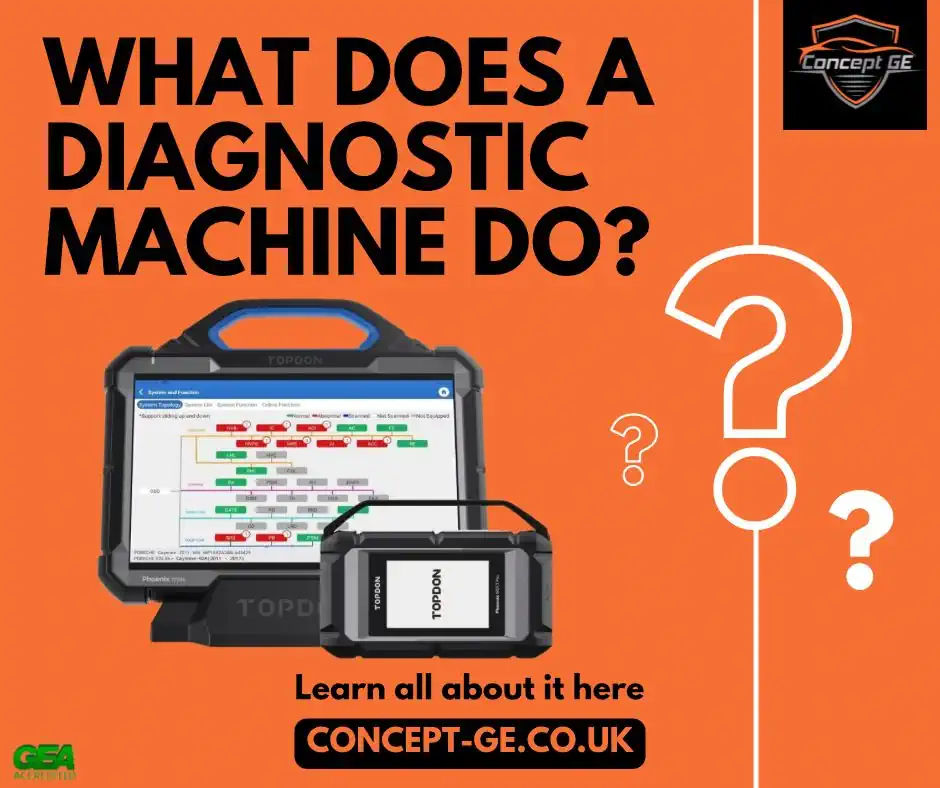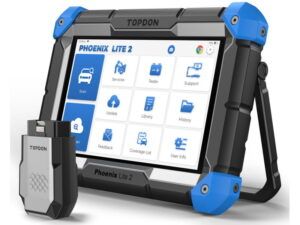Car diagnostic machines work by scanning a car’s individual components and systems to look for any issues that might be present with parts like the engine, transmission system, oil tank, accelerator, and more. However, since these tests need special devices and expertise to be read accurately, they are usually carried out by mechanics at garages or MOT testing stations.
A vehicle diagnostic machine is an electronic scanner that can be plugged into an OBD (OBD 1) or OBD2 socket to read and clear codes, as well as view data readouts from various sensors. This can be used to help diagnose problems with a vehicle.
Car diagnostic tools usually refer to the ODB or ODB2 tools used for diagnosing engine management, and electrical or mechanical faults with a car, but there are several other tools which fall into this category.
What are the different types of car diagnostic machines?
These are the top 5 main types of car diagnostic scanners available today:
- ODB2 car scanners: used to scan Diagnostic Trouble Codes (DTC) on all modern cars and vehicles
- ODB1 car scanners: used to scan Diagnostic Trouble Codes (DTC) on older vehicles, petrol cars earlier than 2001, diesel vehicles manufactured earlier than 2004 in the UK, and any vehicle manufactured before 1996 in the USA
- Tyre Pressure Monitoring Systems (TPMS): used to monitor and alert to tyre pressure reduction or increase by 25% or more from manufacturers’ recommended inflation levels
- Circuit Testers and Multimeters: used to test electrical circuits and can be used to measure voltage, electric current, electrical resistance and electrical continuity to help determine where certain electrical problems may exist
- Car Battery Testers: a voltmeter used to test the charge in a car battery, often this functionality is combined with the ability to charge or trickle charge the battery and prevent overcharging by constantly monitoring the voltage and condition of the battery
Usually, when garages or mechanics refer to diagnostic machines they are talking about the first of these, and virtually every new car in the past 20 years has followed the OBD2 standard, so this is by far the most popular kind of diagnostic connection used.
What is the difference between an OBD2 reader and an OBD2 diagnostic scanner?
Although the names are used interchangeably, an OBD2 reader is a basic diagnostic tool that can read and display diagnostic trouble codes (DTCs) from a car’s OBD2 port whereas, an OBD2 diagnostic scanner is a more advanced diagnostic tool that can do everything a code reader can do, it can also:
- Read and clear pending and manufacturer-specific DTCs
- Display real-time data from the vehicle’s sensors and actuators
- Perform diagnostic tests on specific systems and components
- Graph and record data for troubleshooting purposes
In general, OBD2 scanners are more expensive than OBD2 readers, but they offer more features and functionality.
Here is a table that summarises the key differences between OBD2 readers and diagnostic scanners:
| Feature | OBD2 Reader | OBD2 Scanner |
|---|---|---|
| Reads DTCs | Yes | Yes |
| Clears DTCs | Yes | Yes |
| Reads pending DTCs | No | Yes |
| Reads manufacturer-specific DTCs | No | Yes |
| Displays real-time data | No | Yes |
| Performs diagnostic tests | No | Yes |
| Graphs and records data |
Which type of diagnostic tool you need depends on your needs and budget. If you are just looking for a basic way to read and clear DTCs, then an OBD2 reader is a good option. However, if you run a garage and you need more advanced features, such as the ability to read pending and manufacturer-specific DTCs, display real-time data, or perform diagnostic tests, then you should consider an OBD2 scanner.
What are Diagnostic Trouble Codes (DTCs)?
Diagnostic Trouble Codes (DTCs) are alphanumeric codes defined for each car by the vehicle manufacturer that are generated by a vehicle’s onboard diagnostic (OBD) system to identify malfunctions in the vehicle’s emissions control system or other major components. DTCs can be set by a variety of sensors and actuators throughout the vehicle, and they can be used to diagnose a wide range of problems, from minor issues such as a loose fuel cap to more serious problems such as a faulty engine sensor.
DTCs are typically displayed on the vehicle’s dashboard warning light, which is often referred to as the “check engine light.” However, some vehicles may also have a dedicated DTC display, or the DTCs may be accessible only with a diagnostic scanner.
Once a DTC has been set, it can be cleared by fixing the underlying problem and then resetting the OBD system. However, it is important to note that some DTCs may remain set even after the problem has been fixed. This is because the OBD system may need to run a series of tests to confirm that the problem has been resolved.
It is important to note that DTCs can vary depending on the make and model of the vehicle. You must ensure you have the correct diagnostic scanner machine that is suitable for the specific make and model of vehicle you are working on, but if you are unsure before purchasing a diagnostic scanning tool then talk to your supplier or call Concept Garage Equipment to advise you on the correct diagnostic tool for your requirements.
What is the best diagnostic machine to buy?
If you are a garage, workshop, MOT Bay or mobile mechanic then having a car diagnostic machine is an essential part of your toolbox. With almost all modern cars having elements controlled and monitored by the car’s computer and ODB system, the diagnosis of a problem can be done much faster, or sometimes can only really be determined by the use of a car diagnostic tool.
We have some of the major brands of diagnostic scanners, and to an extent, the best diagnostic machine for your garage may differ from others depending on your requirements.
If it’s a simple and reasonably priced scanner you are looking for then the TOPDON UK Pheonix Lite2 is an excellent choice, as it comes with the OBD and OBDII can perform full system diagnostics for over 200 vehicle makes including VAG vehicles (VW, Audi) and currently comes with 2 years of subscriptions. The TOPDON UK Lite 2 also supports special functions for several car brands, including Add/Replace Key Fobs, Battery Sensor Module learning, and Tyre Pressure Sensors Learning.
At the other end of the scale is the Hella Gutmann Mega Macs X diagnostics machine. Different from many other diagnostics scanners not only with their revolutionary looks, but this one can connect wirelessly to an external display such as a tablet, notebook or PC. It has inductive charging technology, and diagnostic scanning starts with either a wizard or simply by scanning a QR code. With the addition of the optional MT-USB, you can seamlessly turn it into a two-channel multimeter for voltage measurements of up to 60V, as well as current and resistance measurements, so saving on additional workshop tools since it’s all built into this robust beast of a diagnostic machine.
Help to choose a Vehicle Diagnostic Machine
If you are considering purchasing a car diagnostic machine for your garage, view our selection online or speak to our sales team at Concept Garage Equipment at 0113 469 0572. We can advise on the best equipment to purchase to get you started with vehicle diagnostics or to upgrade to a better model as your business grows. Don’t forget even for mobile mechanics, having a professional car diagnostic scanner is an essential device to help speed up your work and increase your revenue by ensuring you can provide this as a service to your customers.
We can offer you advice over the phone at 0113 469 0572, we sell Car Diagnostic Machines from leading manufacturers TOPDON UK, Bosch and Otofix but if there is anything you need that you can’t see on our website then call us and we will supply you anything you need.
All our product prices include delivery as well as free advice on the best use of diagnostic equipment.
Call us today on 0113 469 0572 or use the website contact form today, we are here to help.




